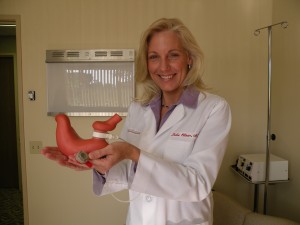Battle of the bulge Obesity Outweights Southern Californians’ active lifestyles

By Andrea Siedsma
Obesity remains the fastest growing public health challenge America has ever faced. Americans’ inability to trim their waistlines is largely attributable to genetics. However, inadequate activity, unhealthy eating habits and changing food alternatives are more significant factors than ever. Over the next few decades, the United States could be facing its first sustained drop in life expectancy in the modern era, researchers say, if its citizens don’t successfully change these bad behaviors.
Here are some alarming stats to digest: the United States is the third largest “fat” country in the world, with 66.7 percent of Americans being overweight, according to the World Health Organization (WHO). The top two “fat” countries are Samoa (93.5 percent) and Kiribati , a small Pacific Ocean island ( 81.5 percent). The WHO says the number of obese people could balloon to 2.3 billion by 2015.
If current trends continue, 103 million American adults will be considered obese by 2018.
The United States is expected to spend $344 billion on health care costs attributable to obesity in 2018 if rates continue to increase at their current levels, according to a report commissioned by the UnitedHealth Foundation, the Partnership for Prevention and the American Public Health Association, in conjunction with its annual America’s Health Ranking report. Obesity-related direct expenditures are expected to account for more than 21 percent of the nation’s direct health care spending in 2018.
Obesity is largely a genetic, metabolic disease, with devastating effects on adults and children, according to Dr. Julie Ellner, one of the country’s leading weight loss surgeons who operates at Scripps Memorial and Alvarado Hospitals in San Diego and is the medical director of Alvarado’s world-renowned Surgical Weight Loss program.
Morbidly obese persons are almost 10 times more likely to die within five years if they don’t undergo gastric bypass surgery than if they do, Ellner said. Morbid obesity leads to a 20-year reduction in life span, a 400 percent increase in the risk of diabetes, 75 percent increase in stroke and 70 percent increase in coronary artery disease. Obesity also is linked to many types of cancer, impaired immunity, sexual dysfunction and infertility. Major depression among morbidly obese persons has reached 89 percent.
Ellner said she’s not treating a patient’s size or their weight — she’s treating the person’s diabetes, high blood pressure, cancer, infertility, joint and back pain, and most importantly, increasing life expectancy and quality of life for people with a disease that will otherwise kill them.
“Gastric bypass and banding surgery aren’t about making people thin,” said Ellner, an active surfer who has obesity in her family. “It isn’t a cosmetic operation. Being a normal size is a nice side effect, but I operate to save patients’ lives.” Gastric bypass surgery makes diabetes and hypertension go away completely within 48 hours in 90 percent of patients. By the time patients leave the hospital after the surgery, they are off all of their medication for diabetes and hypertension. She said obesity is the second leading cause of preventable death in the United States; the leading cause is smoking. “Interestingly, the numbers of smokers is declining, and the numbers of obese people is on the increase. We will soon see the paths cross and obesity will be the leading cause of preventable death,” Ellner said.
Surgery for obesity is widely popular and has become quite commonplace, with 220,000 weight loss surgeries performed in 2008, Ellner said. She said it is the most effective tool available to treat diabetes in morbidly obese patients and also relieves high blood pressure, sleep apnea, cardiac dysfunction, infertility and sexual dysfunction. It is the only treatment for obesity that has proven effective in the long term, according to the National Consensus Panel.
The risk of surgery has dramatically declined over the years and is now about the same risk as having your gallbladder removed, according to Ellner. “However, surgery is only a tool, and patients need to recognize that it doesn’t do the work for them. The most important decision that a patient makes is who performs their surgery. They need to do their research and be informed consumers. They need to ensure that they go to a surgeon who is going to personally teach them how to safely and successfully use their surgery. Without close guidance from their surgeon, they are likely to unintentionally misuse and damage their tool and regain weight.”
What really alarms Ellner is the rise in childhood obesity and the growing need for younger children to have gastric bypass or gastric banding surgery. “The reality is that for children who are 10-to-11 years old who have the obesity gene right now, we don’t have a way of preventing them from becoming obese,” she said. “Eventually they will likely need surgery, but at least they might not be a as sick with diabetes and hypertension if they start eating the right, healthy foods and exercising now. But what we are facing now is a group of children who are already diabetic and some of them are so obese that they are not going to live to be 22 years-old. So, doctors have to operate on these children earlier and earlier because of medical concerns, but they would make better use of the surgery if we were able to wait until they’re 18 or 20 years old.”
Although obesity is, in many cases, genetic, there are a growing number of people — kids and adults— who are gaining significant weight due to bad habits, Ellner said. She said that about 80 percent of a person’s tendency to be obese is genetic and about 20 percent of it is behavioral or environmental. That 20 percent, she said, will continue to swell.
“Our diets and lifestyles have significantly changed in the last 20 years,” Ellner said. “For example, we have a Starbucks on every corner. People think it’s just coffee. But these specialty coffee drinks have hundreds of calories in them. The average Starbucks coffee has a lot of fat and sugar from the flavoring and the milk. Milk is one of the worst things you can ingest if you are trying to control your weight because it is just fat and sugar. Because it’s in liquid form it flushes it into your system faster than sugar that’s in a solid food. It causes enormous blood sugar fluctuations. A lot of people don’t know that coffee, soda and even green, black and white teas have chemical appetite stimulants. Kids are now even going to Starbucks and getting iced coffees and lattes. They may as well be eating ice cream cones every day.”
The economic downturn, plus the fact that most Americans are working longer hours for less pay and barely scraping by to pay their bills, is also a big reason why families are less healthier today. “You have double income households working two jobs, and it’s not like the ’50s or ’60s where mom stayed at home and put healthy meals on the table with fresh organic vegetables from the garden,” said Ellner, who grew up in tiny town called Funk, Neb. “Today, mom is working just as late as dad is. Kids also have more homework these days and they are more stressed and have less time to sit down and eat a healthy meal. Meanwhile, mom is grabbing ‘Pick up Sticks’ or other fast or processed food just to get something on the table. People aren’t eating as healthy when they’re at home.”
Ellner suggests a high-protein, low-sugar diet for both children and adults. “Lean protein should occupy at least 50 percent of the volume of food you eat,” she said. One of the problems these days is the lack of nutritional education among 20+ year olds. Many people don’t know what “lean protein” is. “People think peanut butter is a good source of protein but it’s not because it has a lot of fat and sugar in it. We have to change our thinking about what we think we know about nutrition and read labels to find out what we’re really eating.”
Schools around the nation have a tremendous opportunity to help combat obesity by educating children and their parents about proper nutrition and exercise. So says Deb New, director of communications for Action for Healthy Kids, a Chicago-based national nonprofit organization and volunteer network that fights childhood obesity and undernourishment by working with schools to improve nutrition and physical activity to help kids learn to eat right, be active every day and be ready to learn. The organization provide expertise, volunteers, programs and resources nationwide through a collaboration of thousands of professionals, parents, educators, community volunteers and students, in partnership with more than 65 professional associations, government agencies and corporations.
“We think that schools have a tremendous opportunity to play a leadership role in fighting obesity,” New said. “Kids spend thousands of hours of their lives in school. We work very closely with schools and students to help schools find ways to become healthier places. Healthy kids learn better-the evidence is clear. We have seen some very creative things in the schools we have worked with, for example some teachers are creating ways to get kids moving in a classroom that’s not traditional PE games. These things don’t have to be big or take a lot of money. You have to have to have the desire and willingness to think creatively. We are seeing a lot of that going on.”
One of the organization’s programs is Game On! The Ultimate Wellness Challenge,” which includes a unique tool kit that makes it easy for schools to help youth and their families learn to eat healthy and be active every day. It includes four fun, paired activities, or “challenges,” around making better food choices and moving more.
Another major initiative of Action for Healthy Kids is its healthy breakfast campaign in which the organization issues grants to ensure that schools across the United States can offer students a healthy breakfast before school. Action for Healthy Kids has also pushed in schools across the nation is recess before lunch.
One local school district that has adopted the recess before lunch policy is the Encinitas Union School District. “Research has determined that when children go to lunch at school before recess, they don’t eat as much and tend to be more wasteful because they are focused on getting out and playing,” said Kevin LaPittus, director of child nutrition services for the Encinitas Union School district. “Now that our students are eating after recess, they are taking more time to eat and making healthier choices.”
In 2006, the school district adopted an overall wellness policy that promises to engage students, parents, staff, teachers, food service professionals, health professionals and other interested community members in developing, implementing, modeling and actively practicing, as well as monitoring and reviewing district-wide nutrition and physical activity policies. Under the wellness policy, all students in preschool through sixth grade have the opportunities, support and encouragement for moderate to vigorous physical activity on a regular basis.
The Encinitas Union School District also has changed some of the food and ingredients its uses in school lunches, such as using whole grain bread. For example, instead of ordering pizza through places like Dominos for school lunches (like before) the district now has its own pizza kitchen. “Now we have a lot more control over the ingredients,” LaPittus said. “We make our own dough with a mixture of white and wheat flour and we use a combination of whole milk and low fat mozzarella. We make our own sauce so we use less sodium and less sugar. We are making everything from scratch. A slice of our pizza is around 210 calories and 4 grams of fat as opposed to 230 calories and 8-to-10 grams of fat from the other pizza were serving. “If a child has a slice of pizza with a salad and apple slices and milk, it makes for a healthier lunch.”
LaPittus and his staff also go into the district’s classrooms and educate students and teachers about nutrition through presentations like a food guide pyramid bingo game. The district also holds annual wellness forums for parents. “An important component of education is that we also need to model what we want our children to follow.” LaPittus said. “Our wellness policy was put into place not just for the kids but also for the teachers and staff. It’s very contradictory to say the kids need to eat fruits and veggies while teachers are snacking on cake in the staff lounge. We have also talked to parent-teacher associations about not doing ice cream and cookie sales as fundraisers and have tried to offer other alternatives. “
A federal grant for the county of San Diego will also help increase healthy eating in local schools. In March, the county Health and Human Services Agency (HHSA) was awarded $16 million from the federal Centers for Disease Control and Prevention to promote physical activity and healthy eating. Throughout the two-year “Communities Putting Prevention to Work” grant period, HHSA will collaborate with numerous community partners to increase levels of physical activity, improve the accessibility of nutritious foods and reduce obesity and other chronic diseases. San Diego County is among 44 communities in the country to be awarded funds through this federal competitive grant process. Grant projects will include: increasing the consumption of healthy and locally grown food in schools, foster group homes, senior meal sites and other locations; increasing the number of farmers markets that are participating with nutrition assistance programs; boosting opportunities for physical activity in before/after school programs; and working with land use and transportation planners to increase opportunities for residents to be physically active and eat nutritious foods.
“It’s important to remember that a poor diet, lack of physical activity and smoking are three behaviors which contribute to the four major chronic diseases that are responsible for more than 50 percent of deaths right here in our community,” said Dr. Wilma Wooten, county public health officer. “Preventing disease is possible. Sometimes a few lifestyle changes will make the difference.”
Local health and wellness coach Raquel Robles uses a comprehensive holistic approach to help her clients lead healthier lifestyles. Robles, owner of Encinitas-based Fitness for Living, crafts individual nutrition and fitness programs for her clients. Her main objects are to help people lose body fat and tone up; reduce pain or recover from injury; manage daily stress; improve their energy; and excel in a specific sport.
One of the biggest health issues people have, Robles said is not drinking enough water. “Our body is about 70 percent water, so when you don’t drink enough water you are not cleansing your body — everything remains stagnant,” said Robles, who also works with clients at The Fitness Studio in Solana Beach. “Water not only helps increase your metabolism but it also helps detoxify your body. The first thing in the morning you should drink at least two glasses of water, even before your coffee.”
Robles said it’s all about changing our daily habits. “Most obese people can’t go to the gym and lift weights. But I always tell them to find something you enjoy doing,” she said. That applies to anyone. If you like bike riding, go for a bike ride. Or even go for a half-hour walk. You don’t have to go on a three-hour walk. As long as you’re moving that’s the most important thing. Make it a habit.”
Robles advises to try avoid eating soy, gluten, wheat and pasteurized dairy, all of which does not digest well. Eat good fats, she said, such as avocadoes, coconut oil or even drizzle olive oil over veggies. “It’s really simple,” she said. “You just have to be willing to make a change. I tell my clients, ‘You can pay me now or pay me later. You can do the work on your health now or do more work later. It’s up to you.’”


